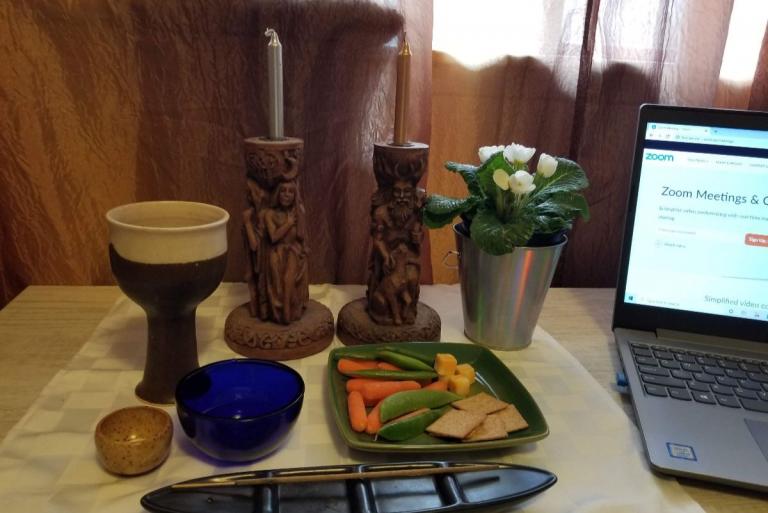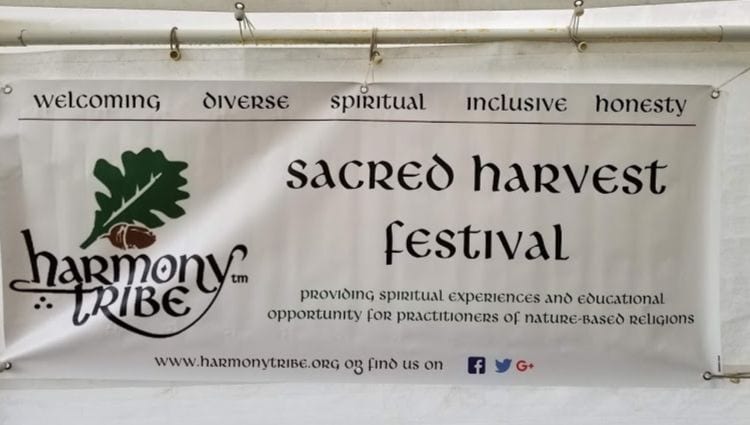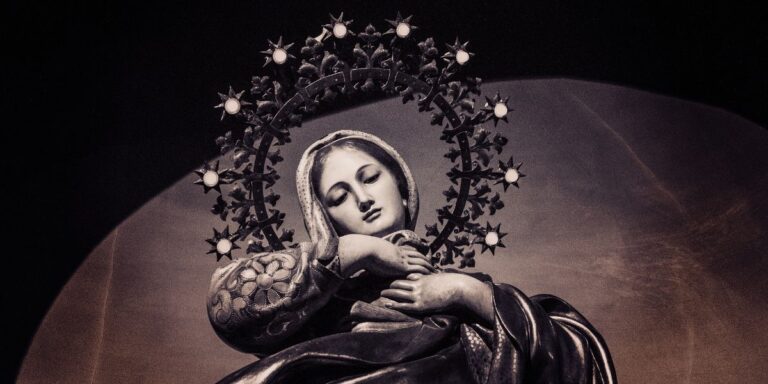We can’t always meet in person. Your coven, grove or lodge might decide to cancel your next get-together to maintain social separation to slow the spread of coronavirus, or a group member may be travelling but still want to participate. When the group can’t get together physically, can you still meet? With today’s video conferencing technology it’s easier than ever to connect online. Here’s how to hold a group ritual where some or all of the members dial in.
Pick a conferencing system
Zoom, Skype, Google Hangouts and Facebook Messenger all offer group video chats. During the coronavirus crisis their terms of service are shifting and some are expanding their free offerings.
For video conferencing, connectivity may be an issue. If the signal is lower quality for any individual person they can join with audio only and still participate.
Pick a coordinator
The first time the group meets it’s helpful to have just one coordinator. That person is responsible for organizing the meeting date and time, managing the technology, and coordinating communication during the video conference.
The coordinator can be the ritual leader but doesn’t have to be. The ritual leader can run the circle while the coordinator provides tech support.
Get the software
The coordinator should send out a link to the software along with the meeting invitation. Before the meeting members should download the software and test it. That said, there’s always someone who postpones this to the last minute and then hits a technical glitch. The savvy coordinator builds in a ten-minute buffer at the beginning of the meeting to solve everyone’s technical issues.
Adapt the ritual
Whatever ritual the group uses will need to be amended for the video conference format. One ritual writer might be responsible for the rite, or the group might make joint decisions about what to do. The coordinator will need to circulate the amended ritual to the group before the conference.
One of the big differences between an in-person meeting and a virtual meeting is the technical lag time. Two people speaking at once may be heard at the same time or may be staggered from one another. There’s also the possibility of feedback. To accommodate these limitations it is a best practice for only one person to talk at a time. If several people are in the same room using one connection, that group of people can talk or chant together when it is their turn. Everyone who is not talking should be on mute.
This means that group speeches need to be reassigned to single speakers. They can be shared out in any way that makes sense to the group. For example, to call the quarters, one person can call air, a second person fire, a third person water and a fourth person earth. Alternatively, one person can be responsible for reading all the invocations.
Establish the astral temple
To connect members who are physically separated, the group will need to create or reinforce an astral temple. Here are some ideas:
- A circular clearing in a grove of ancient trees
- An open-air temple of white marble pillars with a white marble floor
- An island in the center of a deep blue lake
Before the conference the ritual leader should visualize the temple and set it up for the group. Every group member can also visit the temple and put energy into sustaining it.
Set up individual altars
Every member of the group can set up a personal altar for the ritual. Any small table or even a corner of a desk will do. The altar can have:
- An altar cloth
- A small bowl of water
- A small bowl of salt
- An incense holder with a stick or cone of incense
- Any deity images appropriate to the ritual
- Seasonal items, like flowers or leaves, appropriate to the ritual
- Ritual food, such as wine and cakes
The computer or phone can be on the altar or next to it.
When the group meets physically the group casts a circle in a single room. With a video ritual each member casts the circle in their own room using the tools on their altar. At the same time each member participates in the astral temple where the group is collectively calling quarters and casting the circle. Here’s one way to think about it: the individual circles are all gates to the astral temple where everyone is meeting.
Launch and manage the conference
It’s a best practice for the coordinator to launch the meeting a few minutes early. When everyone joins, and any glitches have been worked out, the ritual can get started. The group can take a moment to visualize the astral temple before starting on the invocations and physical actions. While the ritual proceeds the coordinator can monitor the chat for questions and troubleshoot any technical issues that crop up. The ritual leader or the coordinator can keep the ritual moving, calling on people when it is their turn to talk.
The group may decide to have social time before or after the ritual itself. In that case the coordinator can act as host, keeping the conversation moving, and making sure to start the ritual starts and ends gracefully.
Coordinator check list
Here’s a check list for the coordinator.
Before the meeting
- Download the software and test it.
- Set date and time.
- Send out notices. Include link to download software.
- Send out ritual. Record role assignments.
During the meeting
- Launch the conference.
- Troubleshoot technical issues.
- Turn over to the ritual leader (if it’s not you) to keep the ritual on track.
- Close the ritual and thank everyone.
- Close the conference.
After the meeting
- Collect notes from the group about what worked, what didn’t, and what you’d like to try next.
- Make any revisions to the ritual that the group decides. The ritual leader may take on this task and issue an updated ritual for use next time.
Ritual Outline
Here’s an outline for a video conference ritual. It’s perfectly workable and I encourage you to try it out! You can also use it as inspiration for adapting or writing your own ritual.
- Settle in. Make sure everyone is connected to the conference, has the ritual handy, and has collected the tools they need.
- Come together. Ground and center by taking deep breaths and feeling into the earth.
- Join the astral temple. The ritual leader can read a description of the astral temple. Every member takes a few minutes to see and feel the temple.
- Purify the temple. The speaker says “Salt join water.” Everyone sprinkles a bit of salt into their water bowl. The speaker says “Water and earth, let this place be cleansed and purified for our purpose.” Every member sprinkles a little water-and-salt in their own physical space, and sees and feels water sprinkled in the astral temple.
- Consecrate the temple.The speaker says “Fire join air.” Everyone lights their stick or cone of incense. The speaker says “Fire and air, let this temple be consecrated to our purpose.” Everyone waves the incense in their room.
- Call air. The speaker says, “Power of air, join our circle.” Everyone bows to the east.
- Call fire. The speaker says, “Power of fire, join our circle.” Everyone bows to the south.
- Call water. The speaker says, “Power of water, join our circle.” Everyone bows to the west.
- Call earth. The speaker says, “Power of earth, join our circle.” Everyone bows to the north.
- Cast the circle. The speaker says, “The circle is cast by each of us and opens into our temple.” Everyone gestures a circle in their own room, then takes a moment to visualize and feel the astral temple.
- Call deity. The speaker says, “Lady of the moon, Lord of the forest, join our circle.” The ritual leader may insert any deity invocation the group uses.
- Speak wishes. Each member may speak in turn, asking for what they wish from the circle, and also speaking any wishes the group has been asked to support.
- Raise energy. The ritual leader may lead a silent meditation. The leader may also chant or play music while members dance or spin in their own personal space. The leader calls when the energy has been raised and sent to support the wishes, for example by shouting, “It is done!”
- Ritual food. Each member eats the food on their individual altar. This is a good time to unmute everyone and let the sounds in all the individual spaces bring everyone together.
- Thank deity. The speaker says, “Lady of the moon, Lord of the forest, thank you for your presence.”
- Thank air. The speaker says, “Power of air, thank you for joining our circle.”
- Thank fire. The speaker says, “Power of fire, thank you for joining our circle.”
- Thank water. The speaker says, “Power of water, thank you for joining our circle.”
- Thank earth. The speaker says, “Power of earth, thank you for joining our circle.”
- Close the circle. The speaker says, “The gates close but the temple remains. The circle is open but unbroken. Merry meet, merry part, and merry meet again.”
The circles cast in the individual rooms have closed but the astral temple remains. Any member can visit at any time to do individual work and to reinforce the group energy.
Getting comfortable online
I have experienced teaching and empowerments online for several years. It is perfectly possible to have magical experiences and form deep connections using video technology combined with the magical technology of the astral temple.
If your group has only met in person it may take a few sessions to get comfortable with this new way of meeting. Some of the group might get silly and make faces at the camera, or complain about the stiffness of the communication, or actively grieve for the loss of physical touch. If you’re used to sharing hugs you’re going to miss that.
On the other hand the technology makes it possible for the group to get together when it’s not prudent or possible to meet in person. That’s a great blessing. Learning how to hold a ritual online builds resilience for the whole group.




